A song to start with.
Albany to Perth via Lake Towerrinning, Darkan, Williams
At the end of the last instalment, we were visiting an inland lake ecosystem degraded by our culture’s activities both at the lake and in its catchment. We noted that the destruction we can clearly see from a biocentric perspective is mostly invisible to the majority of our culture. If you take a person raised in a human feedlot (which is what a city is) out into the surrounding countryside, they are likely to be mostly blind to the extent of the destruction that has been inflicted there by our culture.
Indeed, the more sensitive people escaping their feedlots may be very happy to find themselves with so much space and quiet around them, and with the sight of trees dotted around the countryside, domestic animals in the fields, and cameo appearances by wildlife. In winter and spring, they may be elated by the wide carpeted greenery or by the golden expanses of broadacre canola crops in flower. They may breathe deeply and with pleasure the comparatively unpolluted air of an agricultural countryside, especially if they are unused to hiking for days in remote remnant ecosystems bursting with biodiversity and the marvellous complex fragrances of life in full bloom and interaction. They may feel that all is right with the world away from the cities, even though that is far from the reality; even though the reality is that we are progressively killing all other life on this planet.
Alternatively, some city people may react to an unaccustomed trip through the countryside like this:
Part of the protagonist’s problem is travelling by car. If you walk through a natural forest, the things you can observe are mind-blowing – if you haven’t been to a proper forest, come do a virtual walk with us here. And while on the subject of forests, in case you haven’t seen this – there are some places in the West people do a better job of early childhood education than others:
They might be causing a bit of damage here and there as they play (as adolescent kangaroos will do when they go through a phase of sparring with bushes) but they are also bonding with nature, and experiencing freedom. That bond with nature is so sorely lacking with many city-raised children, and the deficit is detrimental both to a child’s healthy development, and to a biosphere abused by ignorant and/or uncaring adults later on.
I took some photos from the passenger seat as we were driving in the agricultural hinterland after leaving the lake. We weren’t interested in superb quality photographs, just the general pattern.
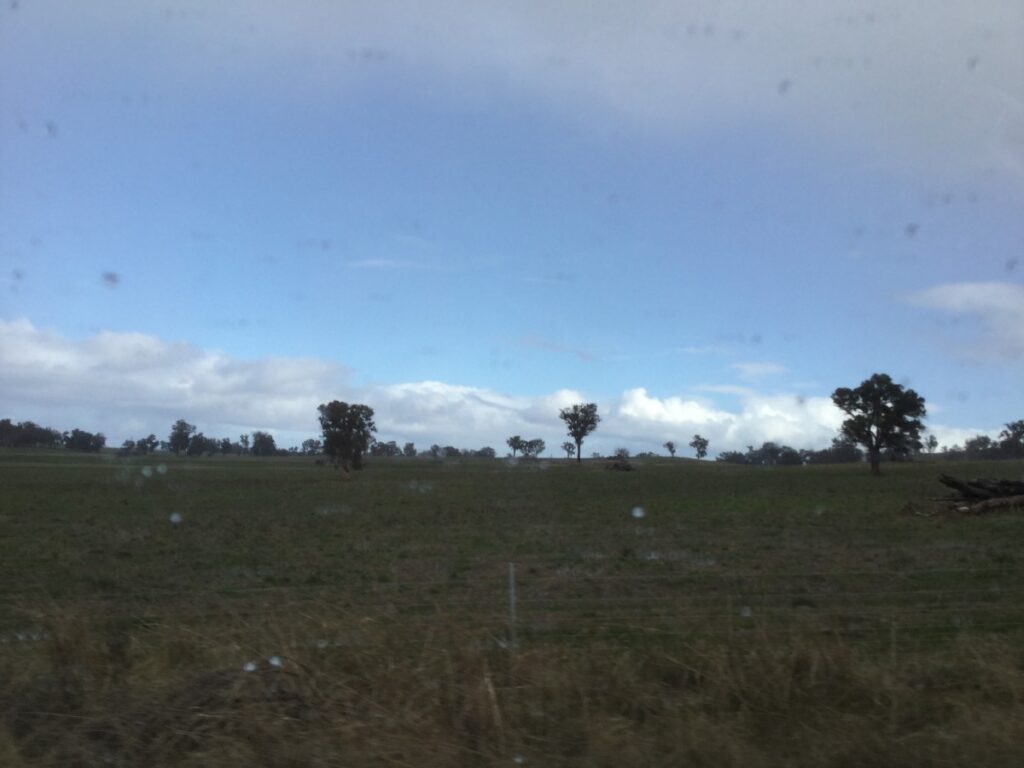
If I went on TV and said that these photos were taken in the Amazon, there would be widespread audience disapproval and outrage. How dare people destroy the rainforest? Don’t they know it is the Earth’s lungs? Why this greed to farm? That is pretty much the standard conditioned response from the section of the mainstream who say they care about the environment. And there is so, so much that this standard conditioned response is missing, including the role of the people who are pointing their fingers in the land clearing. You don’t have to drive a bulldozer to bring this on. You only have to create a market, and all of our outraged will be eating food and using wood products that came from areas that were logged and/or cleared in order to make those products (and yes, that includes soy and every other plant-based food from the agricultural system, including from organic and permaculture farms – better ways to farm, but equally on cleared land). This is why today, we will remember not to criticise our farmers with our mouths full. This is a systemic problem that the entire community needs to own, and this should have happened long ago.
I have long been astonished that while a photograph of cleared Amazon rainforest provokes outrage amongst many of my fellow Australians keen to display their environmental concerns, there is a much more subdued reaction about the ongoing land clearing and logging in Australia. Of course, it is always so much easier to criticise people in another country than your own people or, God forbid, to take a long hard look at your own self in the mirror. It is also so much easier to be blind in your own society or family.
The marri-wandoo woodland pushed over in Lake Towerrinning’s hinterland to create fields and paddocks for agriculture was no less environmentally valuable than Amazonian rainforests. All of these natural ecosystems have immense value in and of themselves. Natural West Australian eucalyptus woodlands are bursting with biodiversity and home to billions of individuals, and many thousands of species, which have been pushed over – let’s make this clear: bulldozed, annihilated, exterminated – to make way for monocrops and pastures. Our culture does this because rather than eating what is naturally available in an Australian ecosystem, we want to grow and eat the things that are familiar from a European agricultural way of life. Also, Homo colossus wants to possess the land, to own it, and how else can you show you own land than by destroying what it naturally carried and imposing your own “improvements” on it?
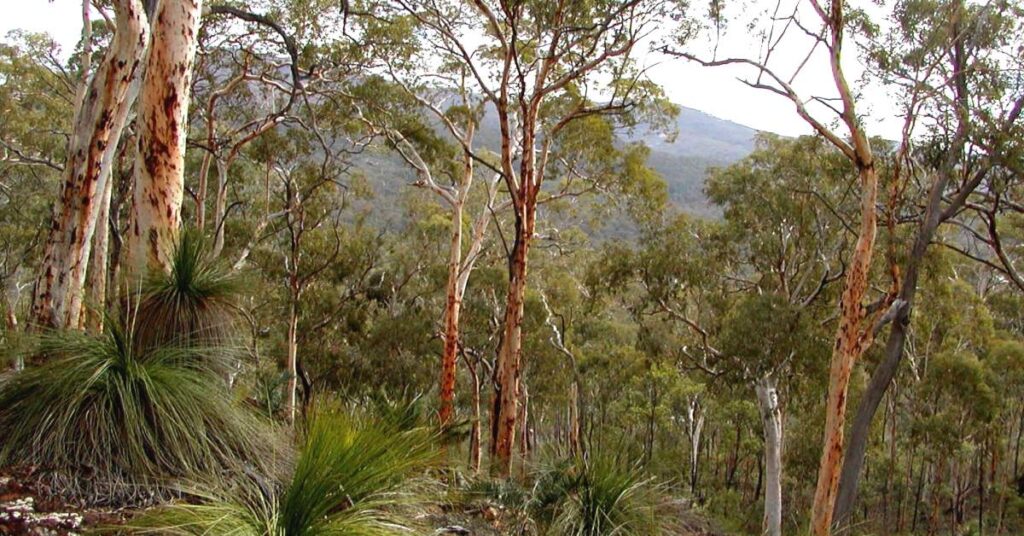
So, “no thanks” to eating kangaroos, wallabies, possums, parrots, witchetty grubs, honeypot ants, lizards, crickets, native tubers and greens, quandong and other fruits. Only savages eat those, and what kind of a sick person would eat Australia’s national emblem? (Insert predictable outrage, ignorance and hubris.)
Those were, of course, among the traditional foods of the Noongar people, alongside fish and shellfish, with which we don’t seem to have such a conceptual problem. And they were foods the Noongar people ate for tens of thousands of years instead of annihilating entire ecosystems and appropriating all of the land for human use, as our culture does.
So what do you think is better – subsisting off the reproductive excesses of various plant and animal species in an ecological community, or annihilating the lot of them, leaving only bare land that you then plant to agricultural species from other countries and on which you run the animals you’re culturally used to eating?
Of course, what our culture does currently supports more human beings per square kilometre, and has gotten us into population overshoot. Combined with rabid resource consumption, this is causing wholesale environmental collapse. It’s a problem humans are largely refusing to own and they are mostly continuing along the path that was started generations ago with industrialisation and, before that, with the spread of agriculture. Some thinkers take it even further and venture that the trouble began when our ancestors came out of the trees. One way or the other, we lost our way and created terrible havoc on this small blue living planet.
You can see in the photograph below that the natural ecosystems of the Lake Towerrinning hinterland weren’t completely razed to the ground, only >99%. Some trees were left standing. This pattern is called “parkland clearing” and provides some summer shade for livestock. It is influenced by the gentleman’s parks around the manor houses of the British aristocracy. Many of the colonists who settled Australia came from poor families; colonial Australia began with convict boats. What a dream it was for some of these people to be able to own land and turn it into a semblance of the leafy estates of their erstwhile local overlords.
The local ecologies paid the price for that; and as is true today, most people of our culture thought little of it. The millions of living things wiped out in the clearing of a paddock where there was native ecosystem that had spent millions of years evolving to bring these beings to life meant nothing, it was an inconvenience. People broke their backs to do it and made pioneer folklore out of it. Our culture looks back proudly at how it “made” this land. We razed this land. We are a culture of ecocide and pollution, and most of us oblivious. Some think it’s our right, our God-given right or, for the secular, because we are the alleged pinnacle of evolution – Homo sapiens. And some would have done what they did because it was the only way they knew how to get their next meal.
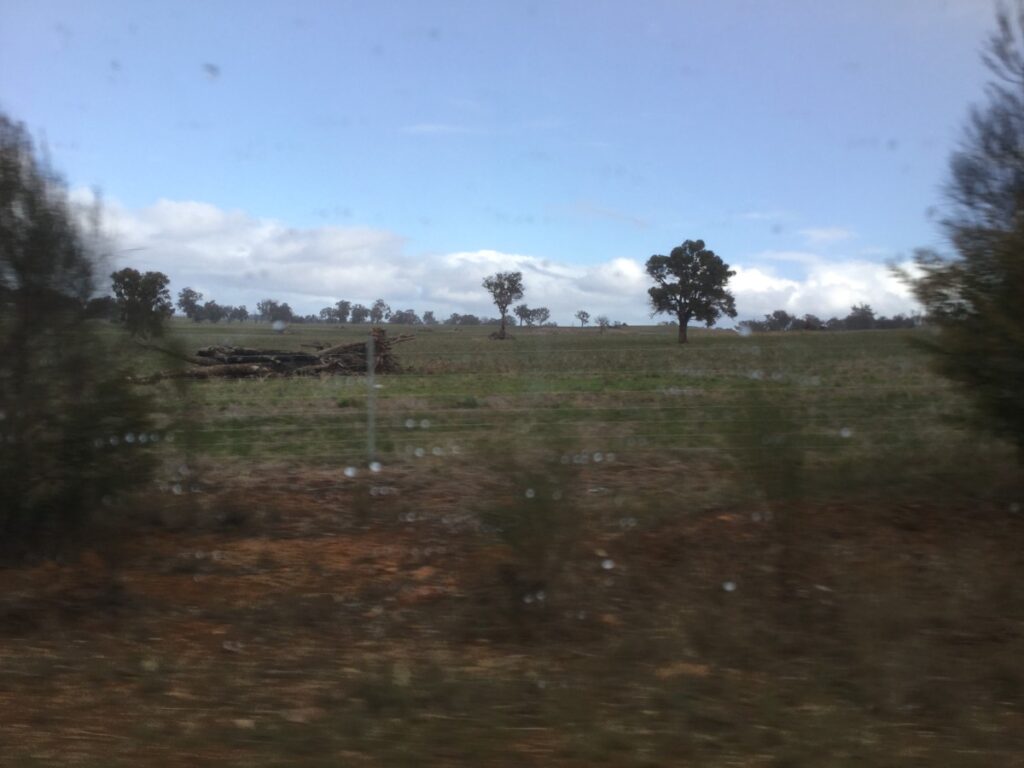
Many city people taking a road trip to the country love to see these beautiful trees; and they are beautiful, and they are alive, and they shade livestock and provide some habitat for our much-abused wildlife. I remember a time when I was a child and had recently arrived in Australia, when I would look out of the window of our car and feel so happy to see these trees dotted all around the farmland. In the hinterland of Munich the fields had been long expanses of nothing but crop, with only occasional hedges. There were some trees planted along roads, and squares of what we called forests but I learnt later, when I had seen real forests in Australia, that these were really just tree plantations; monocultures sharing the ground with weeds, just like the tree plantations in Australia. Real forests are ecological communities – the ones we log and push over to make our Frankensteinian creations.
It was when I was studying Biology at university that one day, looking out of the car window at the passing landscape, I realised that these paddock trees were the living dead, the last of their kin who had been on that ground for many thousands of years. That they are the last remaining witnesses to the devastation of their ecological communities in the past 250 years, in which countless millions of living things had perished en masse. That canopy trees are just a handful of species compared to many thousands that make up the Australian native understoreys, and that these trees depend on that understorey to be able to reproduce themselves. In the croplands and pastures that our culture grafted in under these trees, their seedlings can’t grow. There is no replacement of generations. This is the last of them, and they are dying every day. When they are gone, their local genetic heritage will go with them. If anyone bothers to plant more trees, they will be from nurseries.
I see these remnant trees in the paddocks, and I see how alone they are, how stripped of their erstwhile communities of abundant plant, animal, fungal and microbial life. They are Holocaust survivors, who have additionally been prevented from producing more of their kind.
♦ ♥ ♦
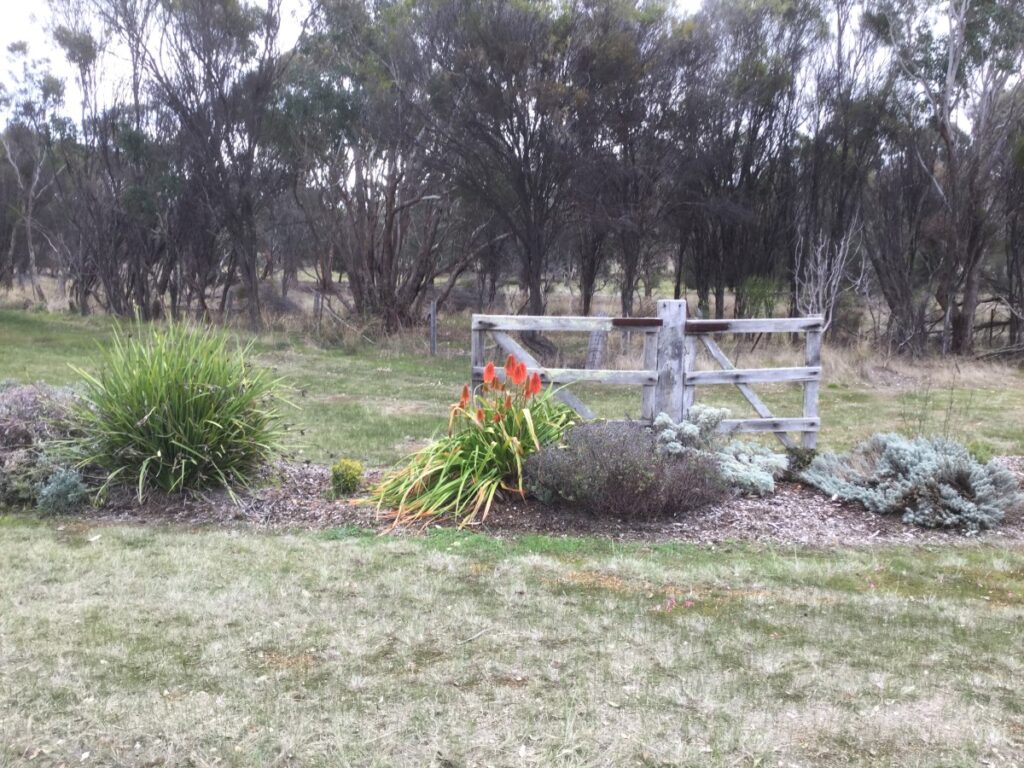
I took the photo above to show another line of languishing remnant vegetation in our West Australian agricultural landscape – and one of those interesting constructs made by modern humans in an effort to “pretty up” one rural town intersection we happened to pass. You can see some more of that intersection below, with a matching bit of landscaping across the road. And I don’t want to belittle the efforts of a community to make their streetscapes less dreary, but I find it so paradoxical how the remnant vegetation is dying a slow death in the background, while the non-local species planted in their display have been taken care of.
We could further ask about the faux fence and think about the fact that wood is tree-meat, and the mulching woodchips are tree-mince. This is just an observation; I use all of the above myself – but I am aware this is what they are. Wood is beautiful and useful; a live tree even more so.
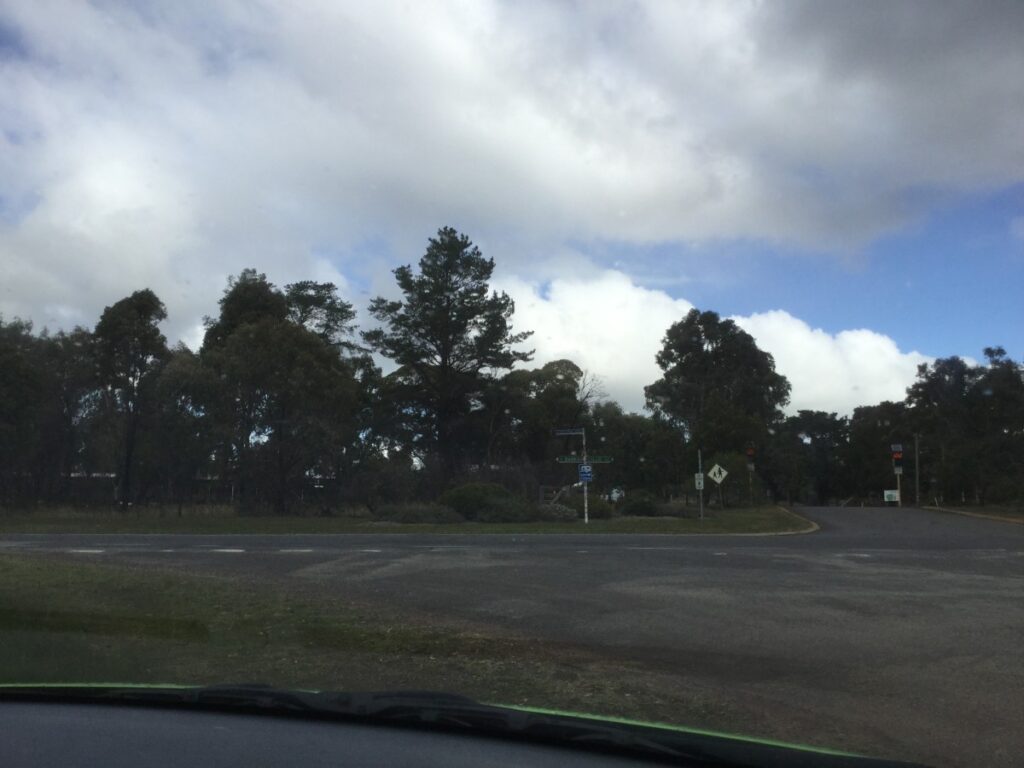
A hop, skip and jump from that intersection, outbound, we found this. Degraded and dying remnant vegetation, and invasive species. The overseas grasses we have introduced for our pastures choke and outcompete many native species, and livestock add to their toll. I very rarely see even a eucalyptus seedling growing up through the imported grasses; especially the perennial runner-grasses. These also kill adult trees by invading the root zones. Of course, additionally there are other issues like water table changes bringing salt to the surface in many inland places.
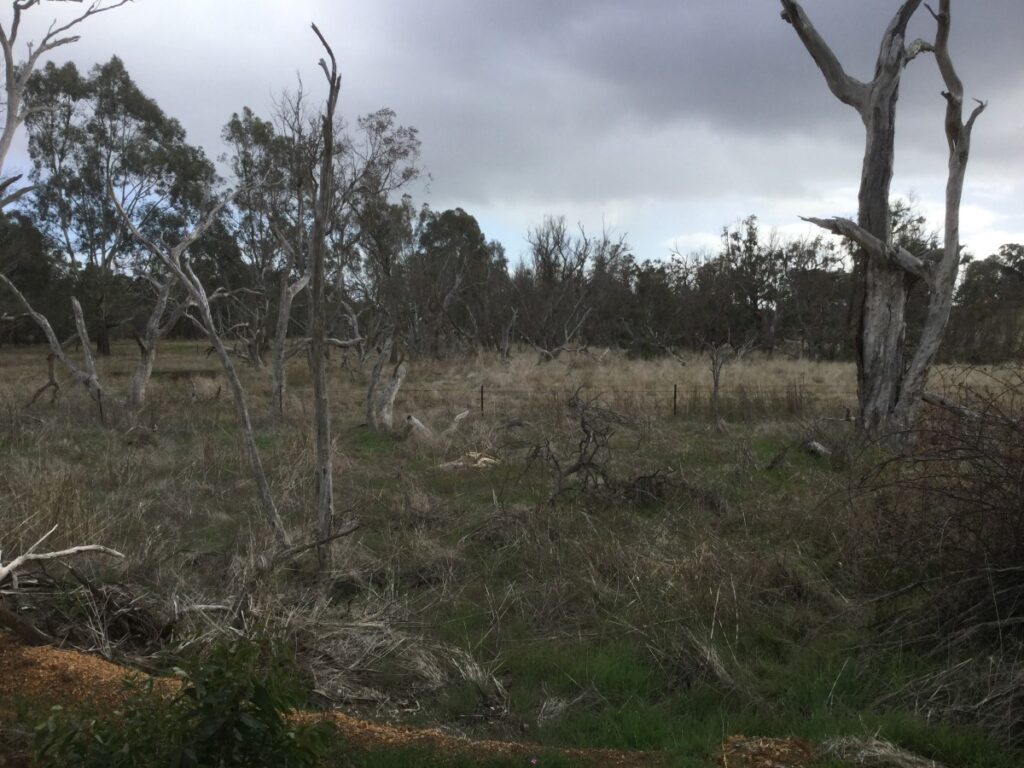
Up to where the fence is, this is just a roadside; and it is typical of inland roadsides, but I was stunned to find something like this so close to the town. This land is dying, does anybody notice?
Not far from there was this stream, in a similar degraded state. A natural stream is surrounded by native riparian vegetation; this is a glorified sewer running through a degraded landscape of dying trees and invasive grasses.
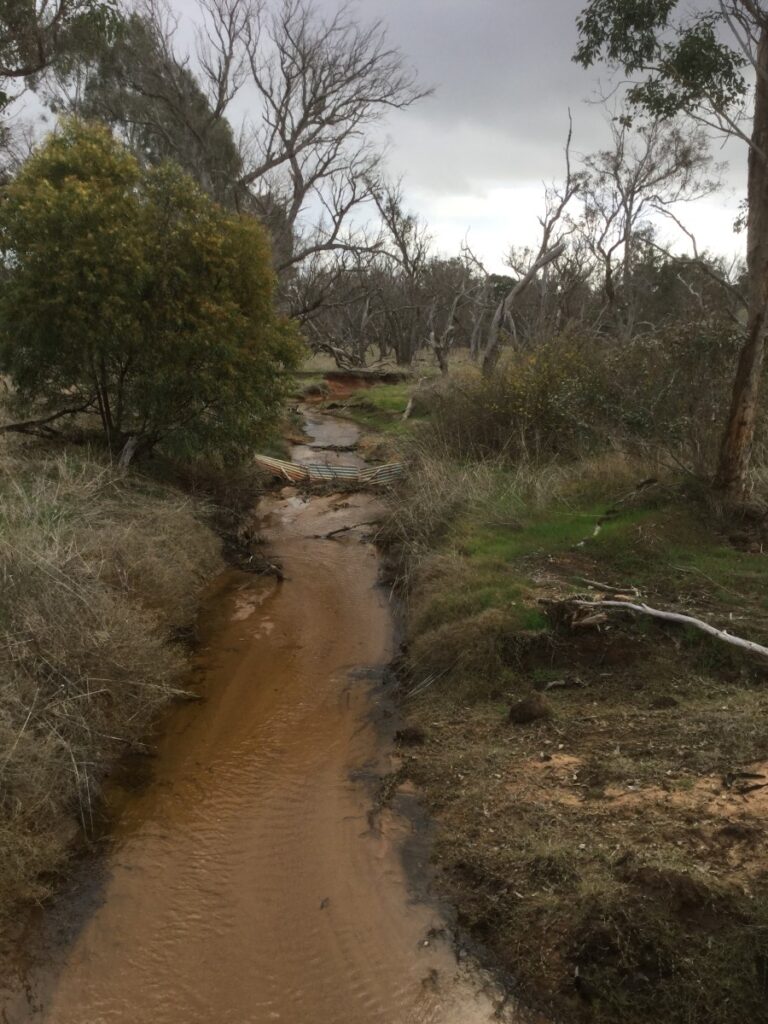
Everywhere our culture has gone, we have turned rivers into drains. We have fished them out and cleared their surrounding vegetation, and straightened them to “improve drainage” causing sediment and nutrients that would normally be trapped by the vegetation and the meandering paths and ponds of a natural stream to be carried in the water. Fertility that should be in the soil causes eutrophication in streams and inlets, killing aquatic life we haven’t overfished directly.
It’s so hard for people who are used to streams and rivers looking like this to understand what the problem is. When they look at something like this it’s not screaming at them like it is for a naturalist. Streams with intact riparian vegetation are rare now; I can’t give you a direct comparison from the native vegetation of this inland area because most wheatbelt watersheds are cleared. This is a satellite photo of South-Western Australia.
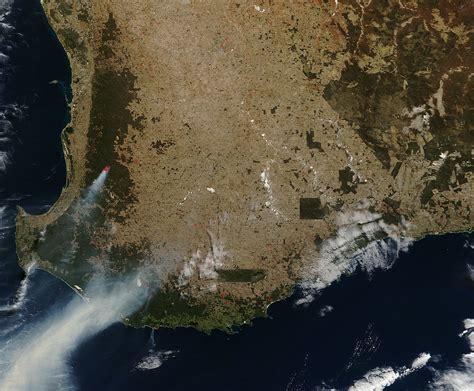
That dark green you see parallel to the west and south coasts and in patches inland is what once covered the whole of this area from the very edges of the coasts. It is deep-rooted evergreen native vegetation and all the other life it supports. In under 250 years, our culture has come along and destroyed the vast majority of it outright, and degraded most of the rest. How we think we can get away with this kind of ecological annihilation and not be destroyed ourselves in the end as a result of all of this is extraordinary. How we have the blindness, the hubris, the lack of a functioning heart to annihilate like this is shameful.
This is a photograph of a comparable-sized stream flowing in a conservation area near the South Coast, with a hiking trail crossing it. The banks here are bare only where the actual trail is. You can see the continuous perennial vegetation covering the landscape, right down to the sides of the stream. This is, above all, life, biodiversity; but it also functions as a filter to trap sediments and nutrients and retain them where they can be used by the plants. The water in this stream supports a plethora of aquatic and terrestrial life; the brown tinge is from natural tannins in the vegetation of this general area.
Continuing with our photographs from our road trip through some of these inland agricultural areas, I just wanted to point out that the West Australian inland cereal growing zone which makes up the majority of the skinned area you saw on the satellite photograph is one of the breadbaskets of our civilisation; like similar areas in the USA, Canada, Ukraine, Russia, India, Argentina etc. Grains produced in these areas are transported by trucks, cargo ships and more trucks all around the world to bring high food mile bread, pasta, semolina, flour etc to human feedlots all around the world.
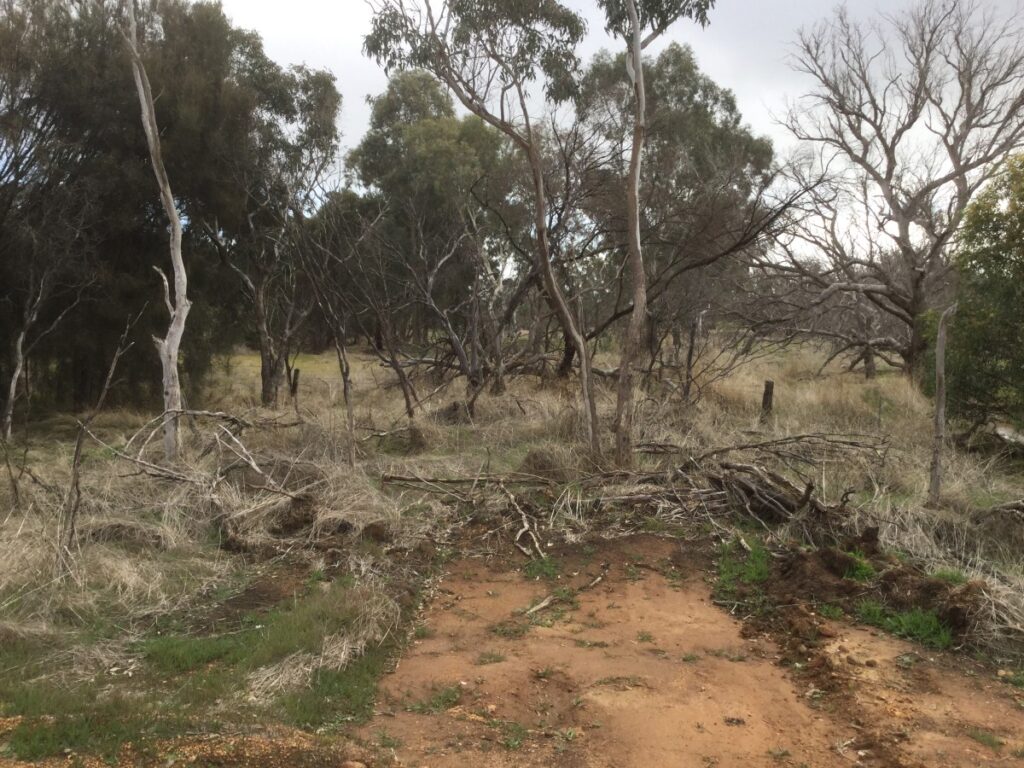
We talk about reducing fossil fuel use, but our globalised food distribution system has destroyed both the idea and the practice of local self-sufficiency. You have to go completely out of your way to buy locally produced food in Australia and other “developed” countries these days – to farmer’s markets, to farmers directly, to little hippie shops and to local produce box distributors. The average shopping trolley from a local supermarket will have under 1% locally grown food in it these days. In our local Woolworths, even the “fresh food” section of meat, dairy and fruit and vegetables will be mostly from other parts of our state, interstate and overseas – even for items grown right here in the district. The milk from local dairies goes in a tanker up to Perth for bottling and if you ever see it again it will have done a 900km round trip. The closest-produced wholemeal flour I can buy at Woolies is from South Australia, so I buy my flour mostly in bulk bags from a biodynamic farmer 200km from us (nearest wheat-growing area) who is stocked by a local bulk food outlet.
But if you think about it, should I be eating wheat if it’s not supported by our own smallholding? We are in a medium-rainfall pasture district that’s optimised for beef and dairy. At home we grow out (on perennial pasture) steers we buy in from a dairying neighbour, keep bees, and try to organically grow as many of our own plant foods as we can. We swap honey out for pastured eggs from one neighbour and grass-fed milk and cream from another (negligible food miles, re-used packaging). We have a small young orchard and I grow vegetables. The most calorie-dense plant food I can grow is potatoes but it’s a high-input crop and I can’t grow enough to sustain us at this point. It’s why I buy flour and bake bread, and buy in pasta, oats, rice, lentils and nuts grown elsewhere.
If we had to live entirely off our smallholding, we’d be eating our own beef much more frequently than twice a week, and I’d be running a house cow myself to milk, and getting a much bigger chunk of my calories and essential nutrients through our own dairy products. I had a milking goat as a teenager and know how to make basic cheese etc. I’d be doubling down on potato growing and trying to save our fruit trees from recent climate extremes, and my husband would have to stop working in town to pay things like mortgage, rates, skyrocketing insurances, car running costs, foods we don’t grow, young fruit and nut trees, occasional new clothes etc. You can’t grow all your food on your own with traditional hand tools only and look after 50 hectares of conservation reserve and write things. For self-sufficiency without fossil fuel inputs you need villages, or to be part of a tribe who knows how to hunter-gather and an intact natural ecosystem. Neither will support our bloated human populations, or average consumer expectations. The average Western consumer would be shellshocked to live like the Brontë family did, and they had it good.
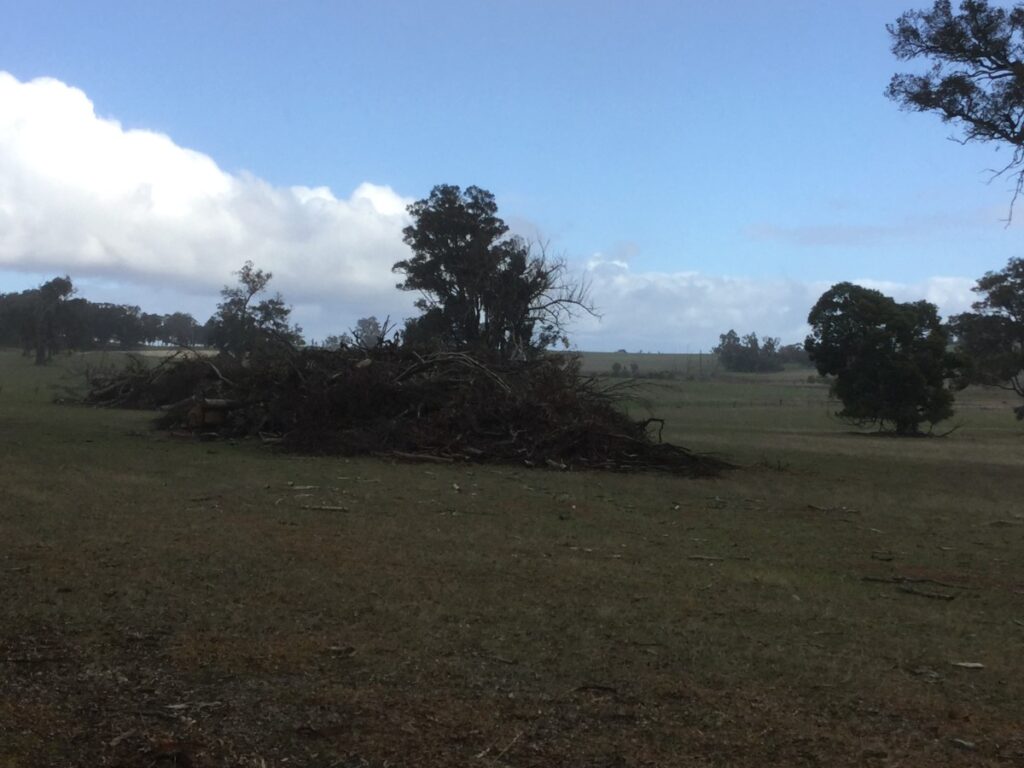
Broadacre clearing as you can see in these road trip photographs was government policy all over Australia. People were threatened with loss of land title if they didn’t comply. Ringbarking, logging, chaining and bulldozing were agricultural policy. After the rise of tractors and other fossil-fuel driven machinery, the destruction could proceed even faster. As farm machinery got bigger and bigger, more trees that had originally been left standing in paddocks were also obliterated so as not to form obstacles for the larger machinery or the straight-line machine sowing and harvesting that is now frequently running off GPS. It’s what destroyed traditional hedgerow farming in much of Europe as well.
In the coastal high-rainfall areas of the South-West, pasture-based beef and dairy farming and intensive horticulture predominate. The lower-rainfall inland areas are used for wheat/sheep farms (complementary, but the sheep are increasingly replaced with additional inorganic fertiliser inputs) and growing other crops like oats, barley, and canola; as well as lupins, field peas and various other legumes. It is these inland cropping areas that are the most cleared of our WA agricultural areas, and the most mechanised and inorganically fertilised. The cereals, legumes and oilseeds coming out of broadacre monocrop production areas like this are essentially fossil fuels in grain form: Fossil fuels to plant the seeds, tend (spray) the crops, harvest the crops, send the crops to market, make the inorganic fertiliser, truck it to the farms, spread it on the farms.
Nearly half of the nitrogen in human bodies now comes from the Haber-Bosch Process which uses fossil fuels to make the nitrogen fertilisers that allow industrial-scale cereal growing. You can read about some of the environmental consequences in the link, and also in Lierre Keith’s book The Vegetarian Myth. I highly recommend that book to anyone who doesn’t come from a traditional culture where people grow their own food organically and without the use of fossil-fuel driven machinery. I regularly spent time in a traditional Italian community growing their own food on hillside smallholdings in the Alps when I was a child: Fruit and vegetables, nuts, berries, goats, rabbits, honey, olives, mountain cattle, cheese, lake trout, corn for polenta. The rice and flour had to come from the Po River plain to the south. Before such regional trade, people just ate what they grew in their area.
These Italians and their smallholdings were my “compare and contrast” to the industrial agriculture I saw in Germany, and again in Australia from age 11. There is little biodiversity in industrial farming areas. In addition, the hillside Italians had different priorities, with a fabulous, local, social food and artisan culture as the centre of life. They were Hobbits, and my husband and I are Hobbits too: Food-growers, foodies, nature enthusiasts, keen hikers, readers, storytellers, focusing on good basics and trying to live simply in a world dominated by Sauron and his planet-destroying military-industrial complex, in which we are now all at least partially enmeshed.
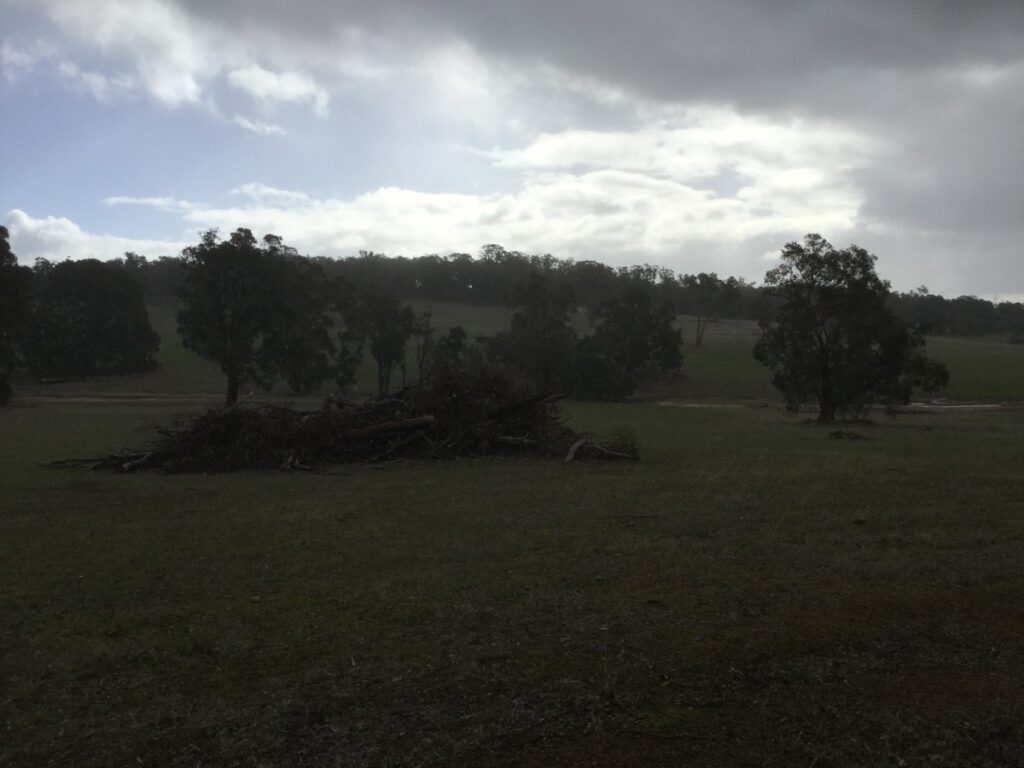
You will notice the stacks of dead trees in the current photographs. When paddock trees die or are inconvenient, they get pushed into piles and burnt later on. One by one they disappear, and their genetic heritage disappears forever. Each lost tree is lost habitat for invertebrate and bird species hanging on by a thread. This is ongoing extinction, caused by our culture.
If you are wondering why more farmers aren’t staying small and doing things more traditionally, and adopting more permaculture techniques, and doing more environmental restoration – it’s because the main driver in this and any other land use in our culture is money, and it is increasingly corporatised as small farmers are pushed out when they can’t make ends meet in the price race to the bottom coupled with increasing costs of production. The few small family farmers I know now have at least one person out making money off-farm, and/or a loyal following at a local farmer’s market willing to pay a fair price for food. Everywhere they are hampered by regulations, fees, centralisation and systemic changes that advantage the “big boys” (and are orchestrated by them and their political friends).
For example, a friend who wanted to run her own small milk bottling plant on her family farm for supplying the local farmer’s market had to fight against being made to build a disability-friendly toilet and shower block for employees she didn’t have and couldn’t afford. The local producer of heritage-breed “slow-grow” free-range chickens for farmer’s market was constantly under threat of being closed down when poultry abattoir regulations changed so that small operations like his were no longer legal, even though his exceeded welfare and hygiene standards. He is only hanging on because he is fighting them and paying for independent testing, but this is eating into his ability to make a living. I have countless stories like this but if you would like to read more, I suggest Joel Salatin’s Everything I Want To Do Is Illegal.
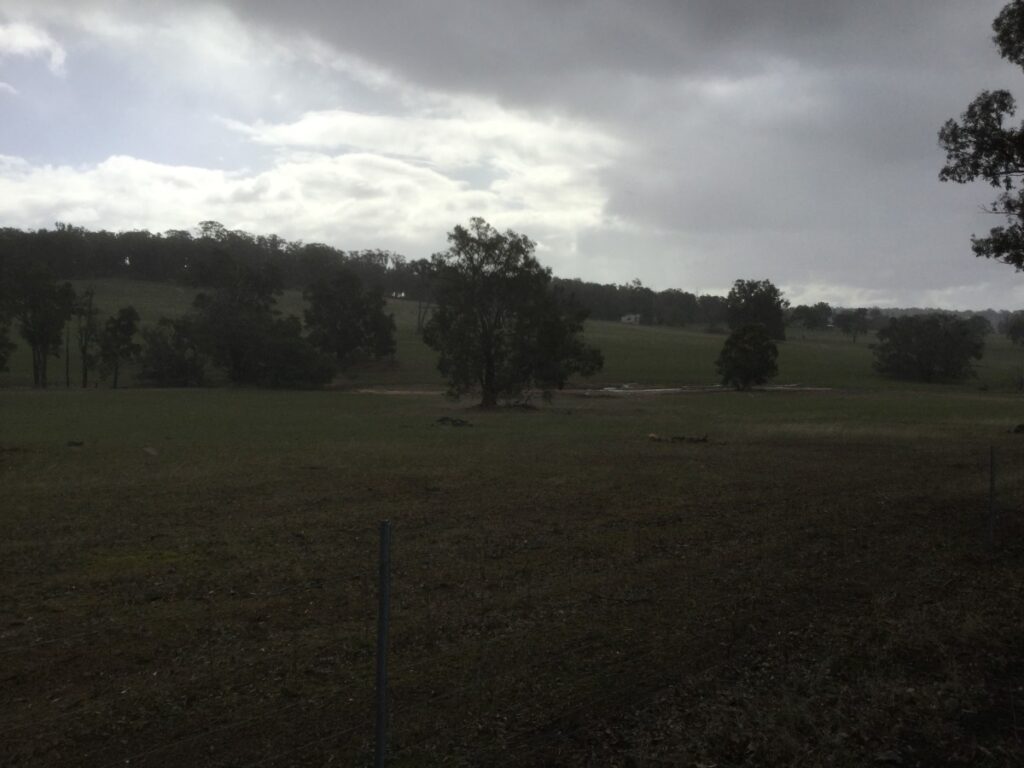
And so, the industrial growing of food in increasingly devastated countrysides isn’t getting any kinder on people or the planet as it supplies the daily bread of the ever-increasing human population overshoot that is now largely feedlotted in cities. Our culture’s dominant system cares chiefly about the extraction of profit from the planet and from human consumers, not about life, least of all non-human life. For a good summary of how this system works, I highly recommend George Tsakraklides’ essay In The Grip Of Necrocapitalism.
♦ ♥ ♦
This is a good place to leave it for today. There is so much to think about and grieve just in this instalment, and any additional clips and links will start to overload a reader, if they haven’t already. Next time we will wend our way through more food-producing countryside towards the state forests adjoining the outer Perth Metropolitan area, into which we might descend, depending on how much discussion necessarily arises from the photos. Meanwhile, I wish all of you well with your own grappling with these issues, and your own efforts to reduce harm to the planet’s biosphere while living a life that hopefully keeps you nurtured and balanced and in authentic connection with others. ♥

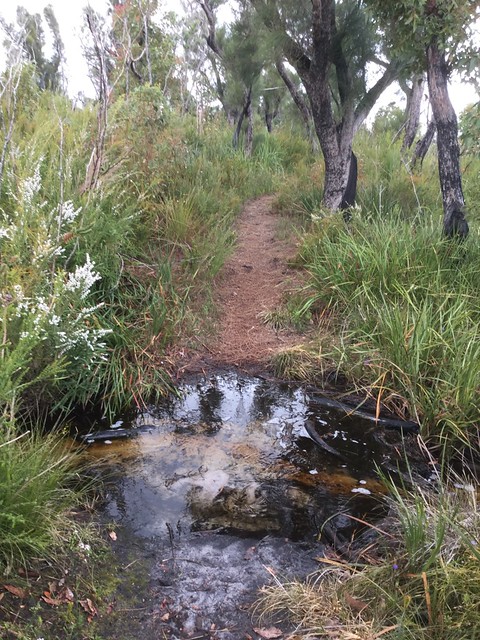
Can we erase the last few thousand years of European/Scandinavian history? Run it back and re-evaluate?
Got a magic wand, Doomfrog?
Different continents, different species, but the Holocaust survivors are dying everywhere. In many places in North America, no one knows they ever lived.
That’s so sad – many humans are the ultimate battery chickens really, Lyle…living caged in suburbia and in the cages of their minds.